A peep into home kitchens across communities to know their Diwali food signatures — from sweet to savoury and everything in between to gorge on during the festive of lights
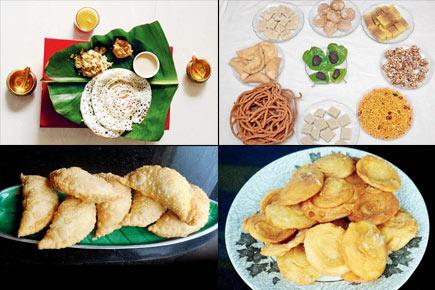
The festival of lights finds myriad cultural expressions across communities, and a quantum of that diversity has its roots in the kitchen. No matter which kitchen you peep into, right from the sweets to the savouries, the mains and their accompaniments, you’ll find some distinct styles and techniques at play, perfected through generations. While more than most of us have succumbed to the convenience of readymade Diwali delicacies, there are some homemakers who continue to whip up the traditional spreads, and make it look easy while they are at it. We entered a few homes in the city to sniff around what’s cooking this Diwali Sunday.
Kannada Diwali Breakfast platter
ADVERTISEMENT
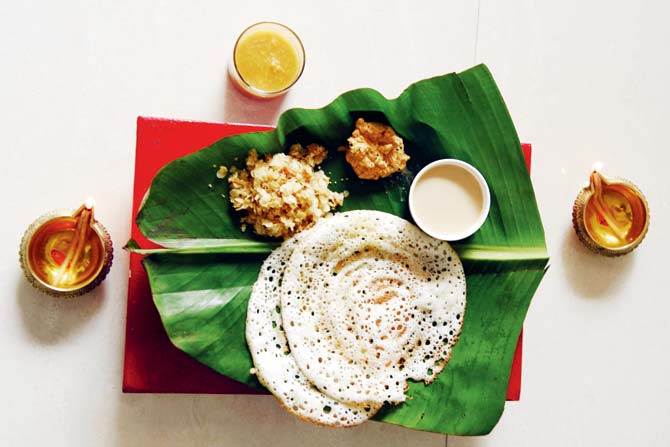
Surnolis, sweet poha, coconut milk with the haseru neru on the side
This comes straight from the South Canara region of Mangalore. We are at the Murthy home in Colaba, where every year, Sandhya Murthy whips up a scrumptious breakfast spread for the family, to mark the start of the auspicious day. The dosa on Diwali is a different concoction from the everyday dosa. “This is called the surnoli dosa, which is made of soaked rice, ground coconut, poha and dahi. The preps begin a night before Diwali, as the batter needs to rest overnight. This is to be had with freshly made coconut milk,” Murthy says. There’s also a poha on the side, made with jaggery, elaichi and coconut — sweet and light, this one is very different from the Maharashtrian kanda poha as we know it.
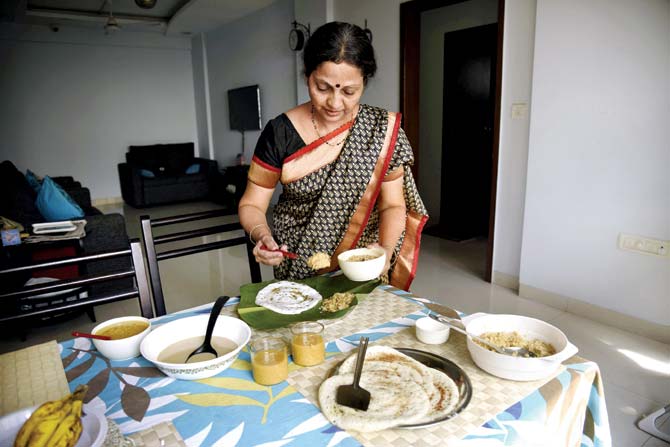
Sandhya Murthy
A moong dal drink made with jaggery, called the haseru neru, is a Diwali morning signature. “Traditionally, this is not a breakfast drink. It’s to be had after the early morning bath, to cool the system down. The coffee is for later, with the breakfast,” she explains. The consistency of the haseru neru is thick but it sits lightly in the stomach, and the jaggery leaves a sweet aftertaste. The breakfast platter sets the tone for the day, which has an elaborate lunch in the wings. In fact, for this community, Diwali is the only festival that allows non-vegetarian on the plate, Murthy tells us. “Usually we make some fried surmai and sometimes, chicken curry.”
Sweet and savoury Tam-Brahm spread
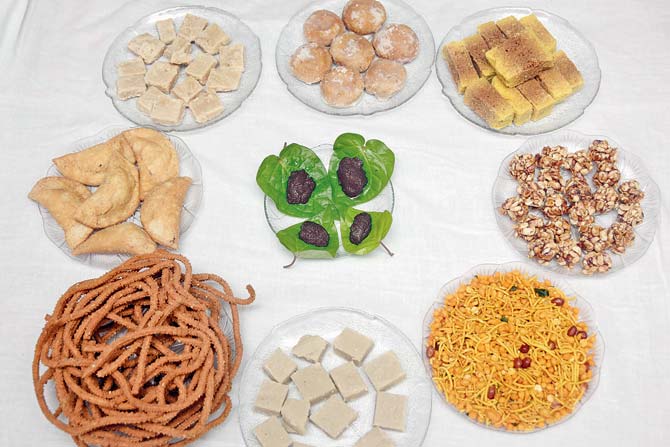
The snack spread with the leghiyam in the centre
As we walk into Gayatri Govindrajan’s home in Chembur, we find her dipping the batter for chakli, but that is only a tiny part of the Diwali dry snack spread. While monitoring the chakli, she sets up a table with plates of cashew-barfi, the Tamil spin on kaju katli — these she makes without ghee. There’s also the badam laddoo, Mysore Pak and the padusha (or the Tam version of the balushahi). A mix of peanuts, fried dals, boondi, crispy poha, straightforwardly called the “mixture”, is also put on the table to offset the sweetness. The lunch spread again is a balance of the sweet, savoury, spicy and tangy elements. The Diwali rasam is always made with dal, which is accompanied by one root vegetable — usually a potato or arbi. Curd is used either in a mor kootu (Tamilian equivalent of the Gujarati kadhi) or as pachadi (raita).

Gayatri Govindrajan keeps an eye on the chakli
Balance is key, in this spread where they even have a Diwali leghiyam (or Diwali medicine). Govindarajan says, “We use long pepper, jeera, dal chini, elaichi, cinnamon and a few herbs. They are sun-dried and powdered and later cooked with water and a little jaggery.” Tradition has it that Iyengars wake up early in the morning, apply oil in their hair, eat a dollop of this leghiyam wrapped in a beetle leaf, before going for a hair wash. “It’s a stomach medicine that prepares the system for all the impending binging,” she adds.
The Jain-Gujju Fada ni Lapsi
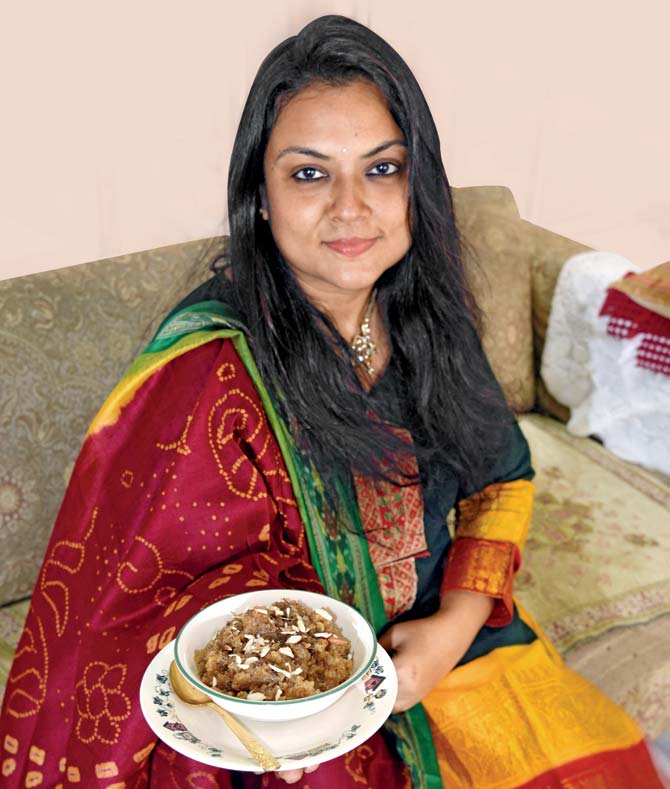
Jayashree with her Fada Ni Lapsi. Pic/Nimish Dave
When artist Jayashree Savani is not holding a paintbrush, you can catch her in the kitchen. In fact, when we visit her Vile Parle residence, she has just completed preparing the Fada Ni Lapsi. Also known as Gujarati daliya lapsi, this sweet dish is famous in western India, especially in Gujarat. “It’s a perennial favourite during festivals like Navaratri, Janmasthmi, Diwali and Dhanteras,” says Savani, who learnt the preparation 20 years ago from her mother. Made of broken wheat, jaggery, saffron paste and cardamom, the dish is soft and smooth in texture and sprinkled with almond and pistachio slivers. One bite, and we can feel the richness of the desi ghee. “It takes about 40 minutes to prepare this. The tedious bit is cooking it on a slow flame for 30 minutes or till the broken wheat is almost done. All through this, you have to continuously stir the batter,” she says. While it is also possible to make fada lapsi in pressure cooker to reduce its cooking time, Savani prefers the non-stick pan. “The taste is altogether different.” The dish, she adds, is known for its nutritional value. “It can even replace a meal.”
The Saraswat special ladoos
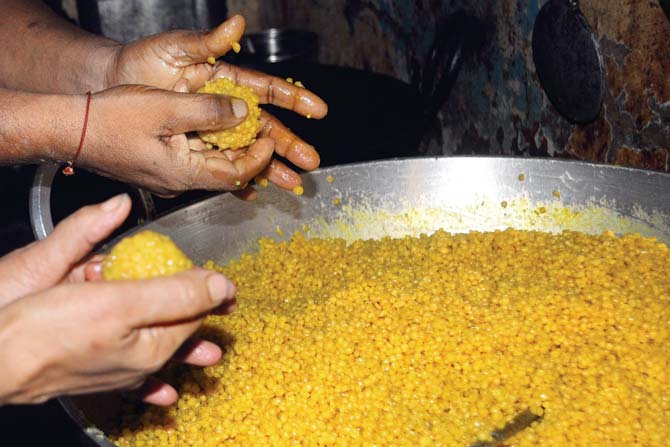
Sunila Mallapur binds the laddoo. Pics/Datta Kumbhar
On a sunny Tuesday morning, when we drop by at Sunila Mallapur’s Tardeo home, she’s in the midst of preparing boondi ladoos from a large vessel. Her hands work like magic as she greases her palms with a drop of ghee, and moulds the laddoo in a perfect round. The dexterity is a result of the over ten years’ experience that the home chef comes with. “In 2006, when my husband and I launched Annaporna Caterers, we decided to offer not just Chitrapur Saraswat breakfast and lunch items, but also Diwali specialties,” she says. Chitrapur Saraswats are a small Konkani-speaking community of Brahmins, who are traditionally found along the Canara coast. The list of sweets and savourites that she hands us is exhaustive with over 21 items on the menu right from saath (a version of the Balushahi), besan ladoo, sugar karanji to chakli bhajni and karo (jada sev).
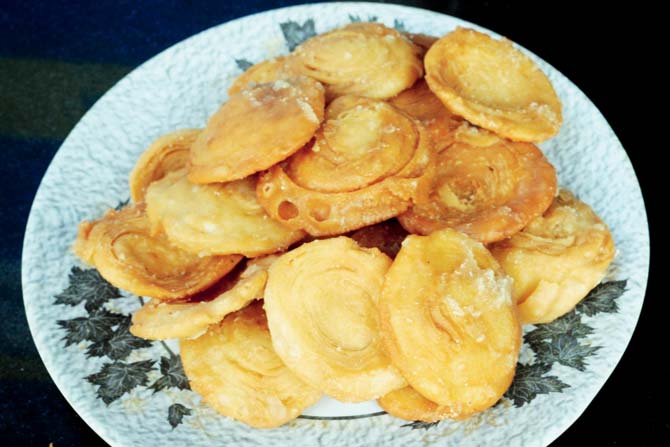
The savoury phenori
“We take the orders 15 days in advance,” she tell us. But we leave the naram (soft) boondi laddoo for the last because they need to be consumed within a week.” But the laddoos are a patron favourite, and it’s easy to figure out why. Dotted with cashews, raisins, saffron and cardamom, the laddoos are delicious. “While mixing water and sugar, you have to hit the right consistency. If you take a drop between your thumb and index finger you can see a single string forming, that’s when you set it aside,” she says. After polishing the laddoos, the 51-year-old offers us the savoury phenori — layered pooris that are crisp in texture. “It can be made with plain flour, for a light texture, or a combination of flour and fine semolina. It is as much in demand as the laddoos because after all the sugar rush, you need some spice to balance it out,” adds Sunila.
The Maharashtrian Nevryo
The nevri (karanji) prepared with dry coconut stuffing might be synonymous with Diwali for most Maharashtrians. But, for Anagha Desai, wife of the late Indian fast bowler, Ramakant Desai, it’s the nevris with gram flour stuffing that have always piqued her interest. And, for good reason. “Traditionally, this was the popular version in the Konkan region, but it has fallen out of favour. Now, it is on the verge of extinction,” says the 68-year-old, who feels there are more takers for the coconut varieity.

So when we visit her sprawling Worli residence, she has already made a plateful of nevris for us. The outer covering prepared using maida and semolina is brittle but tasty with the powdery stuffing made of roasted poppy seeds, desiccated coconut and sesame seeds, making it a delightful combination. “The use of jaggery makes this a healthier snack. It’s a filling dish which has a shelf life of about ten days,” she says. Next year, Desai plans to release a book that will contain vintage Maharashtrian recipes that she learnt from her mother and mother-in-law. “The gram dal karanji will certainly feature in it. It’s my little effort of reviving its popularity.”
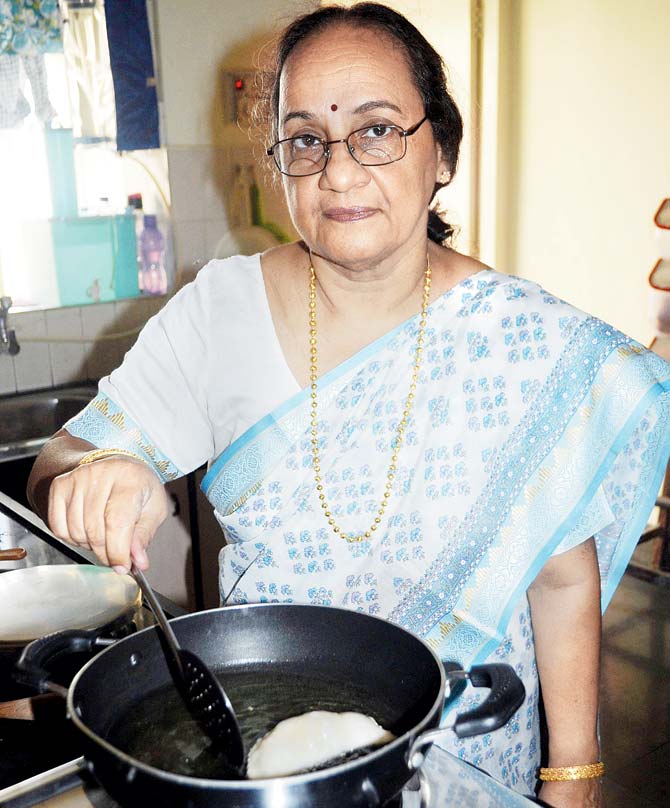
Anagha Desai prepares nevryo. Pic/Datta Kumbhar
 Subscribe today by clicking the link and stay updated with the latest news!" Click here!
Subscribe today by clicking the link and stay updated with the latest news!" Click here!







